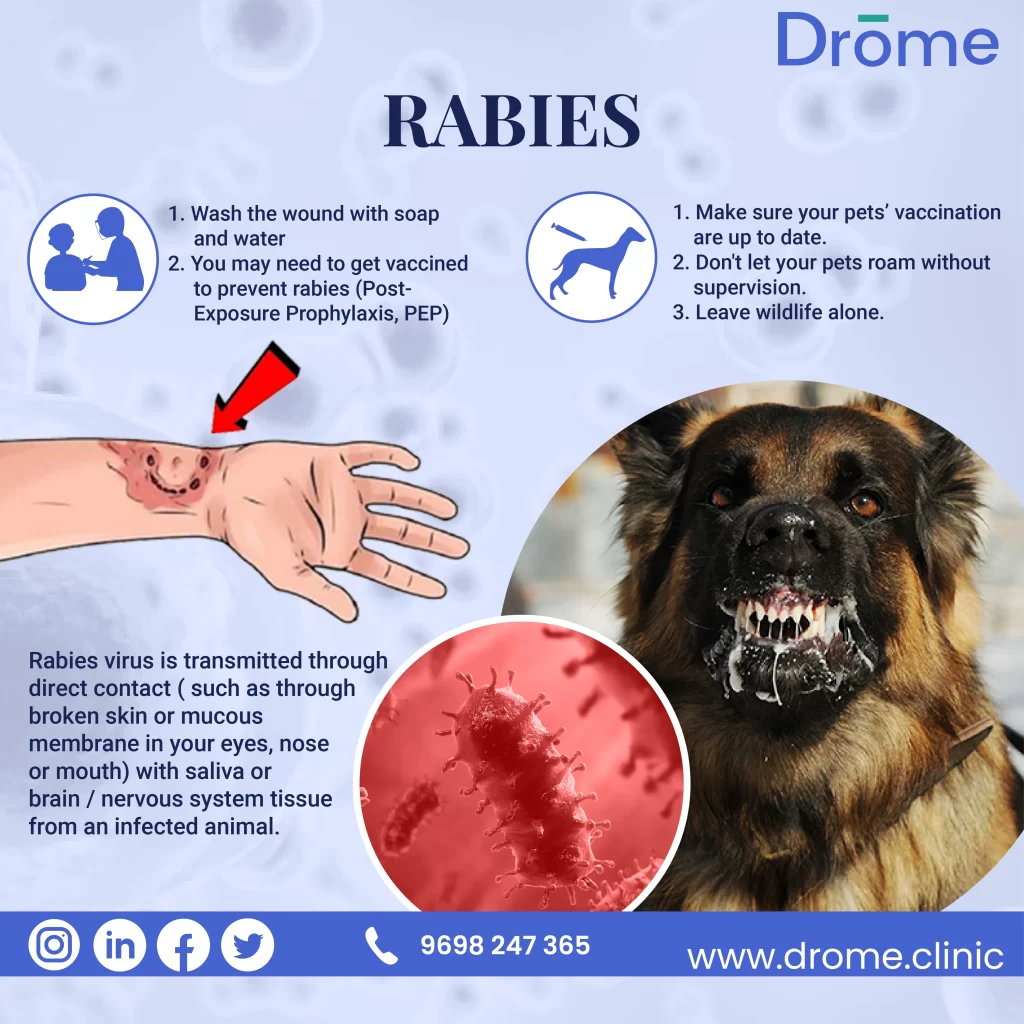Table of Contents
ToggleUnderstanding Rabies
What is Rabies?
Rabies is a fatal but preventable viral diaease. It can spread to people and pets if they are bitten or scratched by a rabid animal*. The rabies virus affects the central nervous system, primarily causing inflammation of the brain and leading to death if not treated promptly.

Causes of Rabies
Rabies virus is transmitted through direct contact (such as through broken skin or mucous membranes in the eyes, nose, or mouth) with saliva or brain/nervous system tissue from an infected animal.*
The primary carriers of the rabies virus are wild animals like bats, raccoons, skunks ,foxes and dogs. However any mammal can contract and spread rabies.
Symptoms of Rabies: A Detailed Breakdown
Rabies is a progressive disease, with symptoms that evolve over time. The period between the bite of a rabid animal and the appearance of symptoms, known as the incubation period, can vary from a few days to several months. It depends on factors like –
- The location of the bite (bites closer to the head and central nervous system tend to show symptoms faster)
- The amount of virus introduced.
- Any existing immunity
Prodromal phase
Rabies virus travels through your nerve cells into your brain and spinal cord, causing nerve damage as it goes. The prodromal phase starts when the rabies virus has entered your nervous system.Its symptoms include:
- Fever.
- Tiredness (fatigue).
- Bite wound burning, itching, tingling, pain or numbness.
- Cough.
- Sore throat.
- Muscle pain.
- Nausea and vomiting.
- Diarrhea.
Acute neurologic symptoms of rabies
Neurological symptoms of rabies are either furious or paralytic. Furious rabies symptoms may come and go with periods of calm in between (furious episodes).
Furious rabies symptoms
- Agitation and aggression.
- Restlessness.
- Seizures.
- Hallucinations.
- Muscle twitching (fasciculations).
- Fever.
- Racing heart (tachycardia).
- Fast breathing (hyperventilation).
- Excessive salivation.
- Two different-sized pupils (anisocoria).
- Facial paralysis (facial palsy).
- Fear of water/drinking (hydrophobia).
- Fear of air being blown in your face/drafts (aerophobia).
- Delirium.
Paralytic Rabies symptoms
- Fever.
- Headache.
- Neck stiffness.
- Weakness, especially starting from the body part that was bitten and progressing to other body parts.
- Tingling, “pins and needles” or other strange sensations.
- Paralysis.
- Coma.#
Prevention Against Rabies
Rabies is almost always fatal once symptoms appear but it is also entirely preventable through proactive measures and timely interventions.
The World Health Organisation (WHO) has come up with Zero by 30 initiative to end human deaths from dog-mediated rabies by 2030
Prevention Strategies
- Vaccinate Pets and Domestic Animals:
- Ensure that dogs, cats and ferrets are regularly vaccinated against rabies.
- This not only protects the animals but also creates a buffer between wild rabies reservoirs and humans.
- Awareness and Education:
- Communities, especially in rabies-endemic areas, should be educated about the risks associated with wild animals.
- Information on what to do if bitten or scratched by an animal can save lives.
- Avoid Contact with Wild or Stray Animals:
- Wild animals can be carriers of the rabies virus. It’s best to avoid direct contact.
- Stray animals, especially dogs in certain regions, can be a major source of rabies transmission to humans.
- Secure Living Areas:
- Ensure that homes and living areas are free from potential entry points for bats and other wildlife.
- Use window screens and seal gaps in homes and buildings.
Post-Exposure Prophylaxis (PEP)
- Immediate Wound Care:
- Wash the wound immediately with soap and running water for at least 10 minutes.
- Medical Consultation:
- Seek medical advice immediately after a potential exposure, even if the wound appears minor.
- PEP involves a series of rabies vaccinations to prevent the virus from progressing.
Post exposure vaccination
- Given to individuals after potential exposure to rabies.
- The vaccine should be given as soon as possible after an exposure but may be effective any time before symptoms begin.
- If you have not been vaccinated against rabies in the past, you need 4 doses of rabies vaccine over 2 weeks (given on days 0, 3, 7, and 14).
- Rabies vaccine may be given at the same time as other vaccines.
Categories of contact and recommended post-exposure prophylaxis (PEP)
Categories of contact with suspect rabid animal |
Category I – touching or feeding animals, animal licks on intact skin (no exposure) |
Category II – nibbling of uncovered skin, minor scratches or abrasions without bleeding (exposure) |
Category III – single or multiple transdermal bites or scratches, contamination of mucous membrane or broken skin with saliva from animal licks, exposures due to direct contact with bats (severe exposure) |
Post-exposure prophylaxis measures |
Washing of exposed skin surfaces, no PEP |
Wound washing and immediate vaccination |
Wound washing, immediate vaccination and administration of rabies immunoglobulin/monoclonal antibodies |
Pre-exposure Vaccination:
- Targeted mainly for those at higher risk of exposure such as veterinarians, animal handlers, rabies laboratory workers, spelunkers, and travellers to areas with high rabies incidence.
- The pre exposure prophylaxis vaccine schedule is a 3 dose series given as 1.0 ml IM injection on days 0,7 and 21 or 28.
Rabies Immune Globulin (RIG):
- Along with the vaccine, individuals who haven’t been previously vaccinated may receive RIG, which will provide immediate antibodies until the body can respond to the vaccine by actively producing antibodies of its own.
- If possible, the full dose of HRIG should be thoroughly infiltrated in the area around and into the wounds.
- Any remaining volume should be injected intramuscularly at a site distant from vaccine administration.
Conclusion
While rabies is a serious and often fatal disease, it’s also preventable. Awareness, proper precautions and timely medical intervention can go a long way in ensuring safety for both humans and animals.
For Rabies vaccination visit: drome.clinic
* CDC #Clevelandclinic







